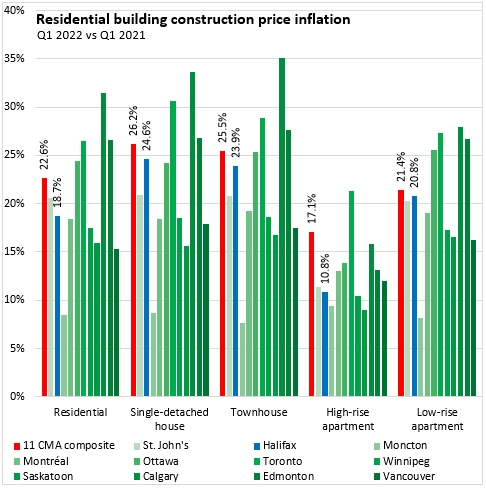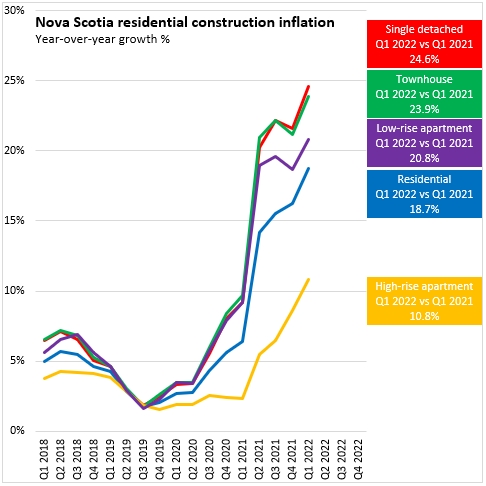For additional information relating to this article, please contact:
July 11, 2022BUILDING CONSTRUCTION PRICE INDEX, Q1 2022 Statistics Canada publishes a 'building construction price index' each quarter for 11 Census Metropolitan Areas. This includes growth in contractors' prices for different types of building construction, including materials, labour, equipment, overhead and profit for the construction of new buildings.
Year-over-year growth (comparing with the same quarter one year prior) shows how building construction costs have risen for a number of different types of structures.
Overall, Nova Scotia's residential building construction prices have increased by 18.7% from Q1 2021 to Q1 2022. Building costs for single detached (+24.6%) and townhouse (+23.9%) units were up by the largest percentages. Building costs for low-rise apartment buildings (under 5 stories) were up by 20.8% while high-rise apartment building costs were up by 10.8%.
For each type of residential unit, the increase in Nova Scotia's building costs was below the national average for similar structures. Residential building cost growth was faster in Calgary and Edmonton as well as in Ottawa and Toronto. Moncton reported the slowest growth in building costs for all categories except high-rise apartment buildings (for which Saskatoon reported the least growth).

Nova Scotia's residential building cost inflation decelerated in 2019 before rising rapidly in Q3 and Q4 of 2020. Building cost inflation accelerated sharply in early 2021 and has continued to rise, with the exception of a deceleration in Q4 2021.

Non-residential building cost inflation is generally slower than residential building cost inflation. Overall non-residential building costs were up 11.4% in Nova Scotia from Q1 2021 to Q1 2022. The pace of building cost inflation was slower for office buildings (+9.8%), shopping centres (+9.5%) and schools (+9.0%). There was faster growth for warehouses (+13.2%), factories (+13.3%) and bus depots with repair/maintenance facilities (+20.1%).
Across the 11 major Census Metropolitan Areas, non-residential building construction costs generally grew at a faster pace than in Nova Scotia. The exception is for bus depot/repair facilities for which Halifax had the fastest increase in building costs. Ottawa and Toronto typically reported the fastest year-over-year growth in non-residential building construction costs while Vancouver reported the slowest or second slowest growth for most categories.

As with residential building costs, Nova Scotia's non-residential building construction cost growth slowed in 2019. There was a subsequent rise in building construction costs in 2020, followed by acceleration in 2021 which carries on into 2022.

Statistics Canada Notes on the Building Construction Price Index: The building construction price indexes are quarterly series that measure the change over time in the prices that contractors charge to construct a range of commercial, institutional, industrial and residential buildings in 11 census metropolitan areas: St. John's, Halifax, Moncton, Montréal, Ottawa–Gatineau (Ontario part), Toronto, Winnipeg, Saskatoon, Calgary, Edmonton, and Vancouver.
These buildings include six non-residential structures: an office building, a warehouse, a shopping centre, a factory, a school, and a bus depot with maintenance and repair facilities. In addition, indexes are produced for five residential structures: a bungalow, a two-storey house, a townhouse, a high-rise apartment building (five storeys or more) and a low-rise apartment building (fewer than five storeys).
The contractor's price reflects the value of all materials, labour, equipment, overhead and profit to construct a new building. It excludes value-added taxes and any costs for land, land assembly, building design, land development and real estate fees.
With each release, data for the previous quarter may have been revised. The index is not seasonally adjusted.
Source: Statistics Canada. Table 18-10-0135-01 Building construction price indexes, by type of building